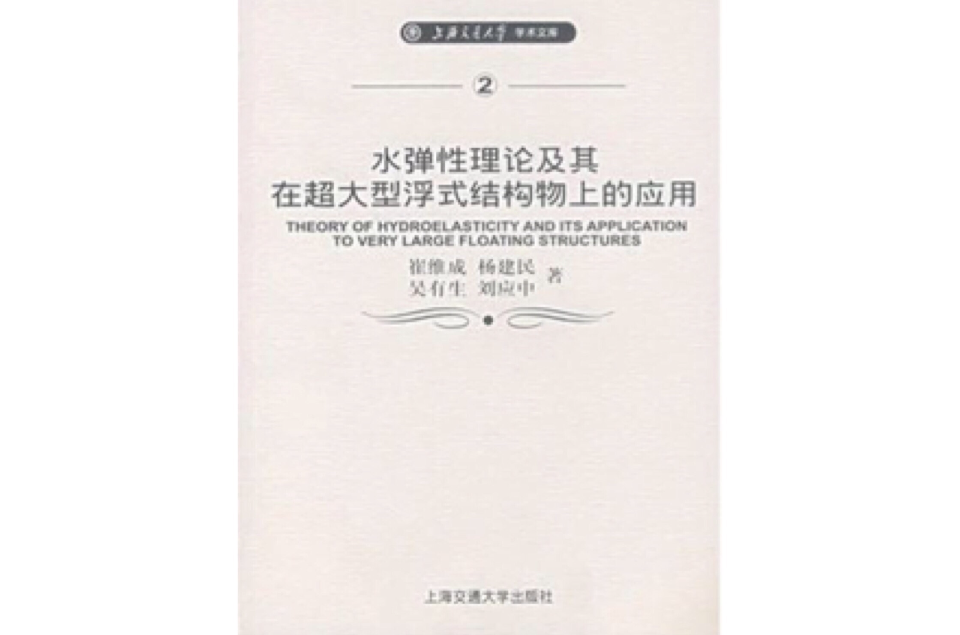《水彈性理論及其在超大型浮式結構物上的套用》是2007年上海交通大學出版社出版的圖書,作者是崔維成。
基本介紹
- 書名:水彈性理論及其在超大型浮式結構物上的套用
- 作者:崔維成
- ISBN:9787313046260
- 頁數:476
- 定價:58.00元
- 出版社:上海交通大學出版社
- 出版時間:2007-3
內容簡介,目錄,
內容簡介
With the fast increase of the population on earth, the supply of resources from land is approaching the limit. More and more people have realized that in order to achieve a sustainable economic development, the resources in the ocean have to be relied on. This is because in the wide ocean whose area exceeds more than two thirds of the earth surface, there exist very rich resources such as sea chemical elements, minerals under the bottom, tidy energy and ocean biological resources.
The 21st century is a century of ocean. Many new industries such as ocean oil and gas, ocean chemical industry, deepsea mining will be formed. In the exploitation of ocean resources and in the utilization of ocean spaces, the international marine community renewed the interest in studying the feasibility of using very large floating structures (VLFS). In order to ensure their safety at sea, their structural responses in the sea are of particular importance. This is fundamentally a hydroelasticity problem. Due to their extreme large sizes, it is a great challenge both in theory and computational efficiency.
目錄
Chapter 1 Introduction to Very Large Floating Structures
1.1 Basic Concepts of VLFS
1.2 History of the Research and Development of VLFS
1.3 Potential Usage of VLFS
1.4 Technical Problems Involved in the Development of VLFS
1.5 Importance of the Hydroelastic Response in the Design of VLFS
References
Chapter 2 A Historical Review of the Theory of Hydroelasticity
2.1 Basic Concepts
2.2 Brief Overview of the Historical Development
References
Chapter 3 Hydroelasticity Theory in Time Domain
3.1 Potential Theory for an Arbitrary Floating Body
3.2 Solution Methods to the Linear Hydroelasticity in Time Domain
3.3 Nonlinear Hydroelasticity Theory in Time Domain
References
Chapter 4 Hydroelasticity Theory in Frequency Domain
4.1 Introduction
4.2 Potential Flow Analysis of a Floating Flexible Body
4.3 Linear Structural Dynamics of Floating Bodies
4.4 Hydroelastic Analysis
4.5 Hydroelasiticity of Flexible Multibody Structure
4.6 Nonlinear Hydroelasticity in Frequency Domain
4.7 Analysis Method for the Mooring System of a Flexible Floating Body
References
Chapter 5 Hydroelastic Response Analyses for MatType VLFS
1.2 History of the Research and Development of VLFS
1.3 Potential Usage of VLFS
1.4 Technical Problems Involved in the Development of VLFS
1.5 Importance of the Hydroelastic Response in the Design of VLFS
References
Chapter 2 A Historical Review of the Theory of Hydroelasticity
2.1 Basic Concepts
2.2 Brief Overview of the Historical Development
References
Chapter 3 Hydroelasticity Theory in Time Domain
3.1 Potential Theory for an Arbitrary Floating Body
3.2 Solution Methods to the Linear Hydroelasticity in Time Domain
3.3 Nonlinear Hydroelasticity Theory in Time Domain
References
Chapter 4 Hydroelasticity Theory in Frequency Domain
4.1 Introduction
4.2 Potential Flow Analysis of a Floating Flexible Body
4.3 Linear Structural Dynamics of Floating Bodies
4.4 Hydroelastic Analysis
4.5 Hydroelasiticity of Flexible Multibody Structure
4.6 Nonlinear Hydroelasticity in Frequency Domain
4.7 Analysis Method for the Mooring System of a Flexible Floating Body
References
Chapter 5 Hydroelastic Response Analyses for MatType VLFS
5.1 General Hydroelasticity Problem for MatType VLFS 156
5.2 Analytical Solutions for Plate Model
5.3 Eigenfunction Expansion Method
5.4 Green Function Method for Plate Model
5.5 Other Mixed Methods
5.6 Time Domain Analysis
5.7 Nonlinear Effects on Hydroelastic Responses of Plate
References
Chapter 6 Hydroelastic Response Analyses for MOB
6.1 Introduction to Mobile Offshore Base
6.2 Connector Load Calculation Model
6.3 Model Test of a 3 Module MOB
6.4 Numerical Results and Analysis
References
Chapter 7 Hydroelastic Responses of VLFS under Inhomogeneous Environments
7.1 Introduction
7.2 Inhomogeneous Oceanic Environments
7.3 Massmomentum Conservation Model of Inhomogeneous Oceanic Environments
7.4 Energy Balance Model of Inhomogeneous Oceanic Environments
7.5 Effects of Boundaries on the Hydroelastic Responses
References
Chapter 8 Experimental Techniques for VLFS
8.1 Introduction
8.2 Progress of the Experimental Research on VLFS
8.3 Experimental Method of VLFS
8.4 Examples of VLFS Model Tests
References
Appendix A Introduction to Some Mathematical Background
Appendix B Introduction to Dynamics of Surface Gravity Waves
Appendix C Introduction to Structural Mechanics
Appendix D Unit Normal Vector of Deformable Structures
5.2 Analytical Solutions for Plate Model
5.3 Eigenfunction Expansion Method
5.4 Green Function Method for Plate Model
5.5 Other Mixed Methods
5.6 Time Domain Analysis
5.7 Nonlinear Effects on Hydroelastic Responses of Plate
References
Chapter 6 Hydroelastic Response Analyses for MOB
6.1 Introduction to Mobile Offshore Base
6.2 Connector Load Calculation Model
6.3 Model Test of a 3 Module MOB
6.4 Numerical Results and Analysis
References
Chapter 7 Hydroelastic Responses of VLFS under Inhomogeneous Environments
7.1 Introduction
7.2 Inhomogeneous Oceanic Environments
7.3 Massmomentum Conservation Model of Inhomogeneous Oceanic Environments
7.4 Energy Balance Model of Inhomogeneous Oceanic Environments
7.5 Effects of Boundaries on the Hydroelastic Responses
References
Chapter 8 Experimental Techniques for VLFS
8.1 Introduction
8.2 Progress of the Experimental Research on VLFS
8.3 Experimental Method of VLFS
8.4 Examples of VLFS Model Tests
References
Appendix A Introduction to Some Mathematical Background
Appendix B Introduction to Dynamics of Surface Gravity Waves
Appendix C Introduction to Structural Mechanics
Appendix D Unit Normal Vector of Deformable Structures

